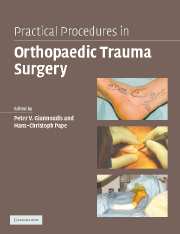Fractures of the cervical spine
from Chapter 15
Published online by Cambridge University Press: 05 February 2015
Summary
APPLICATION OF A HALO AND HALO-VEST FOR CERVICAL SPINE TRAUMA
Indications
Halo devices are used in a variety of trauma settings, including:
Reduction of cervical spine facet subluxations and dislocations (usually via axial traction applied through the halo).
Stabilization of undisplaced cervical spine fractures.
Post-reduction stabilization of cervical spine fractures,\ subluxations and dislocations.
Temporary stabilization of a cervical spine injury, prior to definitive surgical treatment, or to facilitate safe transfer of the patient to a specialist spinal centre.
If the patient is physically able to mobilize, the halo can be attached to a “vest”. The vest may be a custom-made plaster or fibre-glass orthosis, or one of the readily available “off-the-shelf” devices. Several orthopaedic implant manufacturers market combinations of haloes and vest orthoses, in a range of sizes. The most useful halo and vest devices contain no ferrous components and are therefore MRI-compatible, permitting scanning of the patient after application.
Pre-operative planning
Most halo and halo-vest systems are available as prepacked kits containing all of the necessary implants and tools for halo application and subsequent attachment of the halo to a detachable vest.Acareful check of themanufacturer's kit inventory against the kit components and instruments should be done in every case; do not assume that even a pre-packed kit will be complete! If the halo is to be used for ambulatory cervical spine stabilization, a suitably-sized orthosis (vest) is selected. Standard antiseptic skin preparation solutions should be available. If not supplied in the halo kit, a small pointed scalpel will also be needed.
Information
- Type
- Chapter
- Information
- Practical Procedures in Orthopaedic Trauma Surgery , pp. 269 - 282Publisher: Cambridge University PressPrint publication year: 2006
